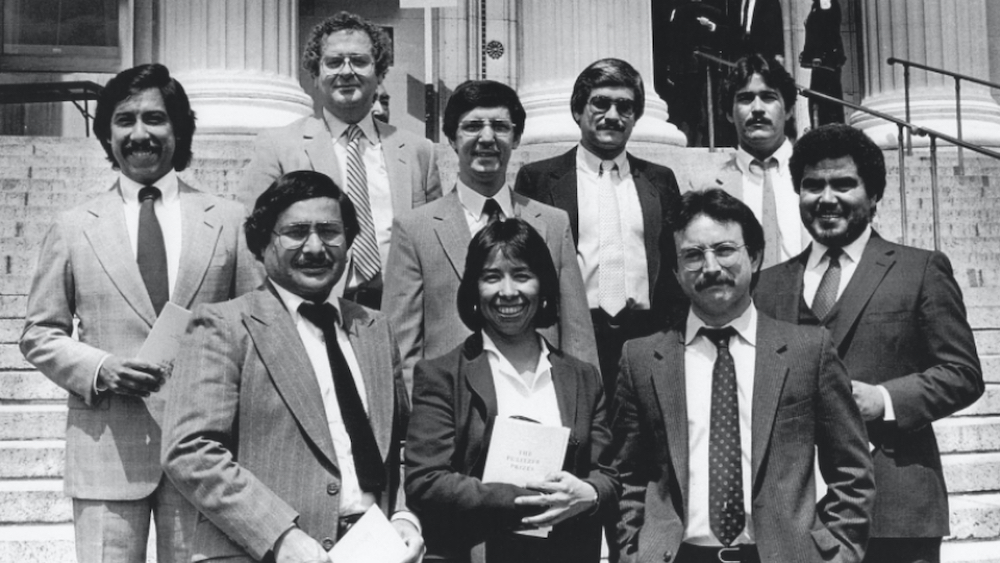Germans have a term — vergangenheitsbewältigung — to describe the process of coming to terms with the past. The concept emerged in the decades after World War II, as historians, philosophers, writers, and thinkers grappled with the atrocities of the Nazi era and with the question of collective culpability.
Newsrooms would benefit from adopting this process for confronting their own histories on race as a way to move forward.
In the month following the brutal killing of George Floyd on May 25, demonstrators flooded the streets of Los Angeles and other cities. Protests erupted, too, in the newsroom of the Los Angeles Times, where pent-up frustrations about insufficient newsroom diversity, and about the framing of stories, were expressed on Slack, Zoom calls and anywhere colleagues could gather.
On June 23, the newly organized Black Caucus of the Los Angeles Times Guild issued a letter calling for improvements in the hiring, promotion and career development of journalists of color, and a profound reorientation of our coverage around communities of color. The caucus also called for a public apology “to confront and make peace with our past.” A month later, on July 21, the Guild’s new Latino Caucus issued a letter of its own, also urging an apology “for fomenting episodes of anti-Latino hysteria in California and the United States.”
As the editorial page editor, it fell to me to draft an editorial apologizing for our racism. It was a daunting task. I’ve only lived in Los Angeles for two years, but even in that time I’ve heard colleagues tearfully describe frustrations and disappointments. For at least 15 years — before the paper was restored to local ownership in 2018 — the Times had endured waves of buyouts and layoffs; several corporate overlords; federal bankruptcy; and a revolving door of editors and publishers.
I read widely, consulting nearly every book that has been written about the Times, including “Thinking Big: The Story of the Los Angeles Times, Its Publishers and Their Influence on Southern California” (1977) by Robert Gottlieb and Irene Wolt; David Halberstam’s “The Powers That Be” (1979); Marshall Berges’s “The Life and Times of Los Angeles” (1984); and Dennis McDougal’s "Privileged Son: Otis Chandler and the Rise and Fall of the L.A. Times Dynasty” (2001).
Those books were only so helpful, however, as they were mostly told from the perspective of the Otis-Chandler family, which controlled the Times from 1882 to 2000, and treated Latino, Black, and Asian Los Angeles as an afterthought. A true people’s history of Los Angeles journalism — told from the perspective of working journalists, and the people they cover — has yet to be written.
But the most powerful insights came from Times journalists, past and present. From the conversations patterns emerged: a history of negligent and insensitive coverage, and cycles of progress and retrenchment in diversifying the newsroom. Newsroom alumni were particularly helpful; the passage of years tends to yield insight and introspection.
Janet Clayton, a 30-year Times veteran, stunned me when she told me that she didn’t read the Times growing up, because her father wouldn’t let it in the house. He thought the Times ignored Black communities or, in the rare instance it covered them, used denigrating stereotypes. He did not live to witness her ascent to editorial page editor and as metro editor, the first Black person to hold either position.
Frank O. Sotomayor, a pioneering Chicano journalist and a 1986 Nieman Fellow, supplied a fascinating online history he had published telling the story of the landmark 1983 series, “Latinos.” (A 2007 documentary, “Below the Fold: The Pulitzer That Defined Latino Journalism,” is well worth watching.) Sotomayor’s papers, housed at the University of Arizona and the University of Southern California, are priceless for students of journalism history.
Dean Takahashi, who was a young business reporter in 1992, rummaged through his house and came upon a box of documents from the aftermath of the Los Angeles riots. He generously scanned dozens of pages of memos and notes, placing the PDFs in a Dropbox and also sharing his own recollections.
Dean Baquet, who was at the Times from 2000 to 2006, first as managing editor and then as the top editor, told me that the fraught history of the past did not weigh on him when he joined. “Keep in mind that for people from Louisiana, Los Angeles was the promised land, the last stop on the railroad,” he told me. “Two generations of Baquets before me had moved there to escape the South.”
I also learned about so many pioneering journalists who have come before us.
Bob Richardson, whose career was cut short because the Times was too indifferent, callous, and short-sighted to make use of his talents.
Ruben Salazar, fatally struck by a tear-gas projectile fired by a Los Angeles County sheriff’s deputy, while covering the National Chicano Moratorium March against the Vietnam War in 1970.
Andrea Ford, a pioneering Black journalist who covered some of the biggest stories of her time — the Loma Prieta earthquake, the beating of Reginald O. Denny, the O. J. Simpson trial — and died far too young.
Jean Sharley Taylor, a daughter of English immigrants who reinvented features journalism, was the first woman to crack the upper echelons of the Times and mentored countless journalists.
K. Connie Kang, the first Korean-speaking reporter at the Times, who was hired after the 1992 uprising and inspired a generation of Asian-American journalists. She died last August, of pancreatic cancer.
Our editorial, in 3,300 words, attempted to chronicle a long history: the rooting of the Times in white supremacy; the Otis-Chandler family’s use of the paper to advance their economic interests; deplorable injustices, such as supporting the wartime incarceration of Japanese Americans. What’s more, some of the shameful episodes were from the recent past: a 1981 series that described Black and Latino criminals as marauders and predators, and a 1994 endorsement for the anti-immigrant re-election campaign of Gov. Pete Wilson.
The editorial was only part of this project.
One of my colleagues, the entertainment reporter Greg Braxton, wrote a bracing reflection about his experiences as a young Black reporter sent to cover the 1992 riots, as I started working on the editorial.
Executive editor Norman Pearlstine, who recently announced he will be stepping down, grasped the parallels between our efforts, and asked our Op-Ed editor, Sue Horton, to edit the articles as part of a project, which grew to include essays by Gustavo Arellano, Sandy Banks, Patt Morrison. and Teresa Watanabe.
“Our reckoning with racism” was published on Sept. 27. In print, the editorial accompanied a powerful letter to readers by Dr. Patrick Soon-Shiong, the first person of color to own the Times, in a four-page special section that Sunday.
From Monday through Friday the following week, the essays by Times journalists appeared on the front page. Arellano chronicled a long history of poor coverage of Latinos, especially ironic given that the region, long before it became part of the United States, was inhabited successively by indigenous, Spanish and Mexican populations. Banks wrote about coming to Los Angeles as a young Black reporter from Cleveland, where the racial paradigm was almost exclusively Black-white. Watanabe described the difficulty of covering communities as heterogeneous as Asian Americans, who vary so much in their origins, languages and migration histories. Morrison described the experiences of two young reporters — one white, one Black — who played crucial roles in the paper’s coverage of the 1965 Watts uprising.
Readers sent us hundreds of letters in response. Some asked whether we were genuinely committed to change — whether this time really will be different. The most powerful letter was from Clint C. Wilson II, a Howard University professor whose journalism career was profoundly shaped by the Times’ racism.
On Twitter, several observers praised the project and called it the first of its kind. That’s not quite true, however. My friend Hank Klibanoff, co-author of “The Race Beat: The Press, the Civil Rights Struggle, and the Awakening of a Nation,” points out that several Southern papers have revisited painful pasts. In Tennessee, The Jackson Sun published a series in 2000 atoning for its poor and biased coverage of the civil rights movement. In Kentucky, the Lexington Herald-Leader published a special report in 2004 with the attention-grabbing note: “It has come to the editor's attention that the Herald-Leader neglected to cover the civil rights movement. We regret the omission.” In Alabama, The Montgomery Advertiser in 2018 called out its past “indifference” to lynchings and other acts of state-sponsored racial terror. These courageous projects inspired our own apology editorial.
What can newsrooms learn from these experiences?
First, acknowledge that newspapers are actors in their communities, not merely disinterested observers. Committed as we are to independence, impartiality and neutrality in reporting the news, we are also civic institutions. Through our action or inaction, the headlines we use, the framing or centering of stories, the choices of what to cover (and what to ignore), and the viewpoints we select for our opinion pages, we shape the communities we cover and the stories they tell about themselves. Often, that “first rough draft of history” has been woefully incomplete.
Second, remember that long after we’ve moved on to the next story, our coverage leaves a deep impression — for good or ill. For example, the Times’ decision in 1994 to endorse Gov. Pete Wilson for re-election, in the same election in which voters passed Prop 187, a measure limiting public services for immigrants, left a bitter aftertaste for Latino readers, one that hasn’t fully faded even after 26 years. In some ways we’re still living it down.
Third, accept collective responsibility for the past. It is not helpful to say, “This didn’t happen on my watch.” It is more helpful to look at the past with moral clarity and to express remorse. Our project was published on the eve of Yom Kippur, the Jewish Day of Atonement — a coincidence, but a fitting one. As Faulkner said, “The past is never dead. It’s not even past.”
Finally — and this is the hard part — recognize that contrition is meaningless without a commitment to change. An apology is just the first step; real progress comes when pluralism becomes unremarkable — when diverse stories, about diverse communities, told by diverse newsrooms, are the norm.
The toughest work is ahead of us — reorienting ourselves around new audiences even as we push forward a digital transformation, in an environment of scarce resources. It will be up to future generations of journalists to hold us accountable; they will assess whether we lived up to our promises.
Sewell Chan is the editorial page editor at the Los Angeles Times.
The Newsrooms We Need Now
As American society—and American newsrooms—grapple with an unprecedented time in the country’s racial justice movement, Nieman Reports is publishing a series of essays about how journalism should respond to the challenges of the moment, from accelerating journalists of color moving into senior decision-making roles to improving coverage of racism and white supremacy.



